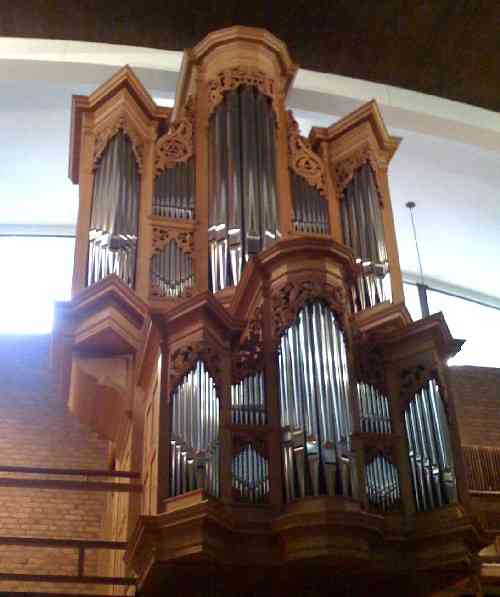
S ome time ago, I was giving a harpsichord lesson and the student was playing this piece by Johann Casar Ferdinand Fischer—‘Uranie’. And in the Passacaglia an idea occurred to me: I noticed a similarity between the development in Fischer’s music and the plot in the legend of Orpheus and Eurydice. The Passacaglia begins in D minor… the accented tritone in measure #3 already indicates danger. Then the descent—descending and descending in D minor: Orpheus is descending into Hades to save [the snake-bitten] Eurydice. Then we have the relative major, F, the sweetest key in this historical temperament, and these trills: Orpheus is overjoyed to find Eurydice, and he begins his return, rescuing her. After the ascent, we have A minor. Orpheus looks at Eurydice, violating the stipulation that had been set in Hades—and the texture of the music thins out, and the furies begin tearing her from him, tearing her limb from limb, and she vanishes…
I said this to my harpsichord student—told my student that this Passacaglia seemed to me to have structural similarities to the plot of Orpheus & Eurydice… and nothing more about it than this. To my knowledge, nobody had ever before considered that Fischer might have been inspired by the Orpheus legend when he composed this piece.
Months after that harpsichord lesson, I Googled ‘Fischer, Passacaglia, Uranie, Orpheus’ to see whether anybody else had had this idea, and to my surprise there was an entry on Wikipedia that said ‘Some experts think that the final dance of the Uranie suite tells the story of Orpheus & Euridice’—but it did not have any footnotes to name who the experts were. Then, some months after that, I Googled it again, and the entry had changed, saying now that ‘William Porter, professor of music at Yale [sic], thinks that this Passacaglia was inspired by the story of Orpheus’. More recently, the entry has been changed yet again, to remove any reference to me.
The moral of this story is that today we can casually invent our own truth. Truth is regarded in a [casual, relative] way. What begins as honest, original speculation gets quickly repeated on the Web, usually stated as fact and usually without attribution.
I like it better when the tentativeness of [my original] conjecture is restored—it ‘might’ be this way; Fischer ‘might’ have been inspired by the Orpheus & Eurydice legend. Speculation and conjecture allow each person to consider an idea and its possibility themselves, and that is far more interesting and beautiful than a [cold, hard] fact.”
— William Porter, pre-performance remarks to audience at BEMF keyboard mini-festival, 11-JUN-2009.
F irst, it is necessary to hold tenure at a prestigious university school of music or conservatory. Second, the person putting forward a musicological opinion should have published extensively in refereed academic journals and be widely regarded as an expert in the field to which the opinion pertains—publishing well-regarded books on the subject, even better. Third, the opiner should cite all previous work by others and present the opinion in a scholarly manner in an appropriate medium or at a worthy venue—certainly not in Wikipedia, which is the quintessential purveyor du jour of all that is unreliable. Fourth, he/she should present exhaustive evidence, detailing each argument that supports the idea and fairly entertaining all rejoinders that are conceivable, summarizing the strengths and limitations of each. Fifth, it is necessary to expressly identify the remarks as opinion only, and to indicate that it should be regarded as tentative, based as it is on conjecture and modest evidence—so that tender babes reading things on the Web will not be deceived or misled.
O r, instead, we can responsibly have fun. And accept that there are valid use-cases besides serious academic ones, and accept that some of those valid use-cases will be fictive and creative ones. Or trust that anyone interested enough to consider some wild, colorful conjecture will be vigorous enough to do their own thinking and fact-checking independently.
 W
W illiam Porter, professor of harpsichord and organ at Eastman School of Music, gave a wonderful performance in yesterday’s BEMF ‘keyboard mini-festival’. He prefaced his performance of Johann Caspar Ferdinand Fischer’s ‘Musicalischer Parnassus—Uranie’ with the humorous story in the blockquote above, about his speculation about similarities between the plot of Orpheus and Uridice and the dramatic arc in Fischer’s Passacaglia in D minor.
I f you’ve read any of my posts here on CMT blog over the past three years, you know that I’m partial to a kind of truth that is like the kind preferred by Michel Foucault—an evolving, exploring kind of truth; one that we ‘inscribe’ and that ‘inscribes’ us. I respect expertise and evidence, but I don’t especially like regimes and power structures that restrict access to expertise and that legislate/adjudicate what evidence shall be admissible. I like knowing things, but I don’t especially like knowledge that needlessly suppresses imagination, play, creativity, art or fiction.
W e might surmise from his pre-performance remarks that William Porter prefers a pluralistic style of truth, and that he prefers this on aesthetic grounds. Is the position that Porter maintains closest to the one that Michael Lynch has written about? You don’t have to insist that there is one and only one true story of the world. And if you reject the unitary position, you don’t have to resign yourself to having no objective truth, every relativist’s view as good as any other's view. Lynch’s brand of pluralism holds that, although there can be more than one truth, there is nevertheless such a thing as objective falsity based on evidence.
T his, I think, is what Porter meant by his wry comments yesterday. There is no evidence to say that Fischer was
not inspired by the legend of Orpheus and Eurydice—nothing that can objectively falsify that conjecture. Yet there is a good bit of musical and circumstantial evidence to support the possibility that the conjecture is true. Aesthetically, Porter’s conjecture makes sense, is coherent, is constructive. The conjecture leads us in interesting, beautiful, valuable directions with regard to understanding Fischer’s music and Baroque interpretation and performance practice.
P orter’s playing yesterday—of the Fischer ‘Uranie’, and of Bach’s Partita No. 4 BWV 828—was wonderful, and his Orpheus & Eurydice story beforehand was provocative, an added ‘bonus’. Together, they were a highlight of my day. Bravo!
P rior to his appointment at Eastman, Porter was a member of the faculty at Oberlin (1974-1986) and the New England Conservatory (1985-2002), and was director of music at Yale Divinity School. He has taught and performed at the North German Organ Academy, the Italian Academy of Music for the Organ, the Göteborg International Organ Academy, the Dollart Festival, the Lausanne Improvisation Festival, the Smarano Organ and Clavichord Academy, the Boston Early Music Festival, and the National Convention of the American Guild of Organists. He is co-founder of the Boston-based Baroque ensembles Affetti Musicali and Musica Poetica. From 1985 to 1997, Porter was director of music at the Church of St. John the Evangelist in Boston. From 1999 until 2002 he was Artist in Residence at First Lutheran Church in Boston, the venue for yesterday’s BEMF keyboard mini-festival. Besides his faculty position at Eastman, Porter teaches part-time at McGill University. And, whether he likes it or not, Porter does have an entry on
Wikipedia. As of this moment, it seems not to contain any errors or wild conjectures.
I ncidentally, if you are attending BEMF, you may be interested to know that there is a copy of Clancy Martin's new book,
Philosophy of Deception, on display in the exhibitors' area on the 6
th floor of the Boston Radisson Hotel. Not sure whether it contains any mention of Wikipedia...

- William Porter page at Eastman School of Music
- ClassicalCat.net ref to comments about Fischer-Orpheus connection made by William Porter during a 23-APR-2006 performance of the Uranie suite at the Yale Collection of Musical Instruments
- BEMF Keyboard Mini-Festival
- Michael Lynch page at UConn
- Truth, according to Wikipedia
- Epstein D. Beyond Orpheus: Studies in Musical Structure. MIT, 1979.

- Lynch M. Truth as One and Many. Oxford Univ, 2009.

- Lynch M. True to Life. MIT, 2005.

- Lynch M. Truth in Context: An Essay on Pluralism and Objectivity. MIT, 1998.

- Martin C, ed. Philosophy of Deception. Oxford Univ, 2009.

- Porter W. Bach Organ of Störmthal. (Loft, 2008.)

- Porter W. Organist. (Loft, 2007.)

- Porter W. Eastman Italian Baroque Organ, with David Higgs and Hans Davidsson (Loft, 2006.)

- Porter W. Music Sweet & Serious, at the North German baroque organ in Örgryte Nya Kyrka. (Loft, 2003.)

- Porter W. One of a Kind: Music of Johann Sebastian Bach. (Loft, 2001.)

- Porter W. Krebs: Clavier-Übung, at the Pehr Schiörlin organ in Gammalkil. (Loft, 2001.)

- Porter W. An Organ Portrait, at the John Brombaugh organ in the Haga Church. (Proprius, 1998.)

















